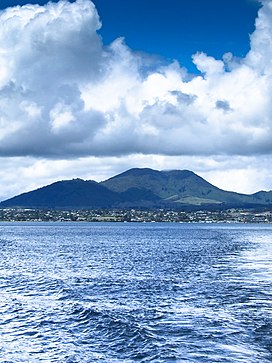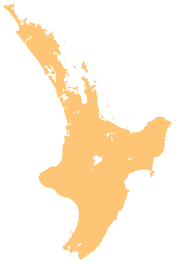Mount Tauhara
| Mount Tauhara | |
|---|---|
 Mount Tauhara seen from Lake Taupō | |
| Highest point | |
| Elevation | 1,088 m (3,570 ft) |
| Prominence | 481 m (1,578 ft) |
| Coordinates | 38°41′40″S 176°9′46″E / 38.69444°S 176.16278°E |
| Geography | |
| Geology | |
| Mountain type | Lava dome |
| Volcanic arc/belt | Taupō Volcanic Zone |
| Last eruption | Around 63,000 BCE |
| Climbing | |
| Easiest route | Hike |
 Map centered on Mount Tauhara that shows approximate selected surface volcanic deposits with dacite in purple, and rhyolite in violet. Rhyolitic ignimbrite surface deposits are various shades of violet from eruptions of the Taupō Volcano. Clicking on the map enlarges it, and enables panning and mouseover of volcanic deposits name/wikilink and ages before present for wider volcanic context. The key to the shading of other volcanics that are shown (active in last million years odd) with panning is basalt - brown, monogenic basalts - dark brown, undifferentiated basalts of the Tangihua Complex in Northland Allochthon - light brown, arc basalts - deep orange brown, arc ring basalts -orange brown, andesite - red , basaltic andesite`- light red, and plutonic - gray. White shading has been used for postulated calderas (usually subsurface now). | |
Mount Tauhara is a dormant lava dome[1] volcano in New Zealand's North Island, reaching 1,088 metres (3,570 ft) above sea level. It is situated in the area of caldera rim overlap of the Whakamaru Caldera and Taupō Volcano towards the centre of the Taupō Volcanic Zone, which stretches from Whakaari / White Island in the north to Mount Ruapehu in the south.[2] It is 6 kilometres (4 mi) east of the town of Taupō, next to the northeastern shore of Lake Taupō.
Formed about 65,000 years ago, Mount Tauhara was not a violently explosive vent, instead slowly oozing a viscous dacitic lava. It is the largest mass of dacite within the Taupō volcano, whose material is 98% rhyolitic.[3] Little evidence of its volcanic past remains today; the peak is covered in dense native bush.
There is a steep walking track to the top of Mount Tauhara, starting at Mountain Road. On a clear day, the summit offers excellent views over the Volcanic Plateau, encompassing the entirety of Lake Taupō in the southwest. The hike is relatively strenuous and takes about an hour and a half each way. The track is not well groomed; being slightly overgrown in some places. However, there is a pristine spring near the top perfect for drinking and the view at the summit is well renowned.
This is the Māori legend about Mount Tauhara:
- The warrior mountains of Taranaki, Pūtauaki, Tongariro and Tauhara were deeply in love with Pīhanga the mountain that stands above Tūrangi at the southern end of Lake Taupō. A battle erupted to win Pīhanga's favour and the victor was Tongariro. At their defeat, the other mountains decided to leave Tongariro's domain, travelling as far away as they could in the course of one night. Taranaki fled west towards the setting sun, and Pūtauaki and Tauhara fled north towards the sunrise. Pūtauaki moved fast and is now located near Whakatāne and is also known as Mt Edgecumbe. But Tauhara was sad and with a heavy heart he traveled reluctantly. When overtaken by dawn he had only reached the north eastern shore of Lake Taupō. Here he stands to this day looking mournfully across the lake towards his lost love, Pīhanga.[4]
- Tauhara is the point to which Ngātoroirangi, the high priest of Te Arawa canoe, and ariki-ancestor of Tūwharetoa, climbed when he first came to the region seeking lands for his followers.[5]
"Tauhara" is Māori for "alone, or isolated".[6]
See also[edit]
References[edit]
- ^ "Global Volcanism Program | Taupo".
- ^ Matt McGlone. 'Ecoregions', Te Ara - the Encyclopedia of New Zealand, updated 21-Sep-2007
- ^ Volcanic Hazards Working Group of the Civil Defence Scientific Advisory Committee, which includes scientists from the Institute of Geological and Nuclear Sciences and the Universities, Number seven "Taupo Volcanic Centre" Archived 2006-10-06 at the Wayback Machine
- ^ Te Ahukaramū Charles Royal. 'Whenua – how the land was shaped', Te Ara - the Encyclopedia of New Zealand, updated 5-Nov-2007
- ^ Grace, J. Te Herekiekie, (1959, reprinted 1992). "Tūwharetoa ; A history of the Māori people of the Taupo district". Reed; Auckland, Singapore.
- ^ Reed, A.W. (1975). "Place names of New Zealand". A.H. & A.W. Reed; Wellington, Sydney, London.



